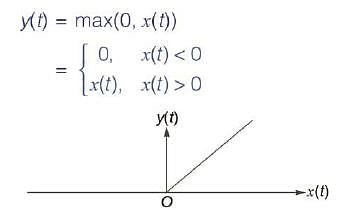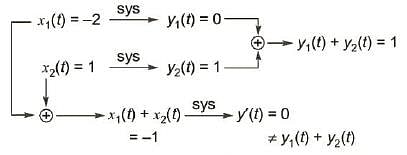Electrical Engineering (EE) Exam > Electrical Engineering (EE) Questions > If the input x(t) and output y(t) of a system...
Start Learning for Free
If the input x(t) and output y(t) of a system are related as y(t) = max (0, x(t)), then the system is
- a)non-linear and time variant
- b)linear and time-variant
- c)linear and time-invariant
- d)non-linear and time-invariant
Correct answer is option 'D'. Can you explain this answer?
| FREE This question is part of | Download PDF Attempt this Test |
Most Upvoted Answer
If the input x(t) and output y(t) of a system are related as y(t) = ma...
Introduction:
In electrical engineering, the terms "linear" and "time-invariant" are used to describe the behavior of systems. A linear system satisfies the properties of additivity and homogeneity, while a time-invariant system maintains its behavior over time.
Explanation:
To determine the linearity and time-invariance of the given system, let's analyze its properties.
1. Linearity:
A system is linear if it satisfies two properties: additivity and homogeneity.
- Additivity: If x1(t) produces y1(t) and x2(t) produces y2(t), then for any constant α and β, the system should satisfy αx1(t) + βx2(t) → αy1(t) + βy2(t).
In the given system, y(t) = max(0, x(t)). Let's consider two inputs x1(t) and x2(t) that produce outputs y1(t) and y2(t) respectively.
- For x1(t), the output y1(t) = max(0, x1(t)).
- For x2(t), the output y2(t) = max(0, x2(t)).
Now, let's consider αx1(t) + βx2(t) as the input to the system.
- αx1(t) + βx2(t) = α(max(0, x1(t))) + β(max(0, x2(t))).
To check additivity, we compare the output of the system for the input αx1(t) + βx2(t) with αy1(t) + βy2(t).
- Output for αx1(t) + βx2(t) = max(0, α(max(0, x1(t))) + β(max(0, x2(t))).
- αy1(t) + βy2(t) = α(max(0, x1(t))) + β(max(0, x2(t))).
Since both outputs are equal, the system satisfies additivity.
- Homogeneity: If x(t) produces y(t), then for any constant α, the system should satisfy αx(t) → αy(t).
In the given system, let's consider x(t) as the input that produces y(t) as the output.
- For x(t), the output y(t) = max(0, x(t)).
To check homogeneity, we compare the output of the system for the input αx(t) with αy(t).
- Output for αx(t) = max(0, αx(t)).
- αy(t) = α(max(0, x(t))).
Since both outputs are equal, the system satisfies homogeneity.
Since the given system satisfies both additivity and homogeneity, it is linear.
2. Time-Invariance:
A system is time-invariant if its behavior remains the same over time.
In the given system, y(t) = max(0, x(t)). Let's consider an input x(t) that produces output y(t).
If we delay the input by a certain time τ, the new input becomes x(t - τ). The output for the delayed input should be y(t - τ).
- For x(t - τ), the output y(t - τ) = max(0, x(t - τ)).
Comparing the original output y
In electrical engineering, the terms "linear" and "time-invariant" are used to describe the behavior of systems. A linear system satisfies the properties of additivity and homogeneity, while a time-invariant system maintains its behavior over time.
Explanation:
To determine the linearity and time-invariance of the given system, let's analyze its properties.
1. Linearity:
A system is linear if it satisfies two properties: additivity and homogeneity.
- Additivity: If x1(t) produces y1(t) and x2(t) produces y2(t), then for any constant α and β, the system should satisfy αx1(t) + βx2(t) → αy1(t) + βy2(t).
In the given system, y(t) = max(0, x(t)). Let's consider two inputs x1(t) and x2(t) that produce outputs y1(t) and y2(t) respectively.
- For x1(t), the output y1(t) = max(0, x1(t)).
- For x2(t), the output y2(t) = max(0, x2(t)).
Now, let's consider αx1(t) + βx2(t) as the input to the system.
- αx1(t) + βx2(t) = α(max(0, x1(t))) + β(max(0, x2(t))).
To check additivity, we compare the output of the system for the input αx1(t) + βx2(t) with αy1(t) + βy2(t).
- Output for αx1(t) + βx2(t) = max(0, α(max(0, x1(t))) + β(max(0, x2(t))).
- αy1(t) + βy2(t) = α(max(0, x1(t))) + β(max(0, x2(t))).
Since both outputs are equal, the system satisfies additivity.
- Homogeneity: If x(t) produces y(t), then for any constant α, the system should satisfy αx(t) → αy(t).
In the given system, let's consider x(t) as the input that produces y(t) as the output.
- For x(t), the output y(t) = max(0, x(t)).
To check homogeneity, we compare the output of the system for the input αx(t) with αy(t).
- Output for αx(t) = max(0, αx(t)).
- αy(t) = α(max(0, x(t))).
Since both outputs are equal, the system satisfies homogeneity.
Since the given system satisfies both additivity and homogeneity, it is linear.
2. Time-Invariance:
A system is time-invariant if its behavior remains the same over time.
In the given system, y(t) = max(0, x(t)). Let's consider an input x(t) that produces output y(t).
If we delay the input by a certain time τ, the new input becomes x(t - τ). The output for the delayed input should be y(t - τ).
- For x(t - τ), the output y(t - τ) = max(0, x(t - τ)).
Comparing the original output y
Free Test
FREE
| Start Free Test |
Community Answer
If the input x(t) and output y(t) of a system are related as y(t) = ma...

Linearity Check :
at input x1 (t) = -2, output y1 (t) = 0
at input x2 (t) = 1, output y2 (t) = 1

Suystem is non-linear because it voilates law of additivity.
Check for time-invariance:
Delayed O/P :

O/P of system when input is x (t - t0) = f(t)

Therefore, system is time-invariant.
Attention Electrical Engineering (EE) Students!
To make sure you are not studying endlessly, EduRev has designed Electrical Engineering (EE) study material, with Structured Courses, Videos, & Test Series. Plus get personalized analysis, doubt solving and improvement plans to achieve a great score in Electrical Engineering (EE).

|
Explore Courses for Electrical Engineering (EE) exam
|

|
Similar Electrical Engineering (EE) Doubts
If the input x(t) and output y(t) of a system are related as y(t) = max (0, x(t)), then the system isa)non-linear and time variantb)linear and time-variantc)linear and time-invariantd)non-linear and time-invariantCorrect answer is option 'D'. Can you explain this answer?
Question Description
If the input x(t) and output y(t) of a system are related as y(t) = max (0, x(t)), then the system isa)non-linear and time variantb)linear and time-variantc)linear and time-invariantd)non-linear and time-invariantCorrect answer is option 'D'. Can you explain this answer? for Electrical Engineering (EE) 2024 is part of Electrical Engineering (EE) preparation. The Question and answers have been prepared according to the Electrical Engineering (EE) exam syllabus. Information about If the input x(t) and output y(t) of a system are related as y(t) = max (0, x(t)), then the system isa)non-linear and time variantb)linear and time-variantc)linear and time-invariantd)non-linear and time-invariantCorrect answer is option 'D'. Can you explain this answer? covers all topics & solutions for Electrical Engineering (EE) 2024 Exam. Find important definitions, questions, meanings, examples, exercises and tests below for If the input x(t) and output y(t) of a system are related as y(t) = max (0, x(t)), then the system isa)non-linear and time variantb)linear and time-variantc)linear and time-invariantd)non-linear and time-invariantCorrect answer is option 'D'. Can you explain this answer?.
If the input x(t) and output y(t) of a system are related as y(t) = max (0, x(t)), then the system isa)non-linear and time variantb)linear and time-variantc)linear and time-invariantd)non-linear and time-invariantCorrect answer is option 'D'. Can you explain this answer? for Electrical Engineering (EE) 2024 is part of Electrical Engineering (EE) preparation. The Question and answers have been prepared according to the Electrical Engineering (EE) exam syllabus. Information about If the input x(t) and output y(t) of a system are related as y(t) = max (0, x(t)), then the system isa)non-linear and time variantb)linear and time-variantc)linear and time-invariantd)non-linear and time-invariantCorrect answer is option 'D'. Can you explain this answer? covers all topics & solutions for Electrical Engineering (EE) 2024 Exam. Find important definitions, questions, meanings, examples, exercises and tests below for If the input x(t) and output y(t) of a system are related as y(t) = max (0, x(t)), then the system isa)non-linear and time variantb)linear and time-variantc)linear and time-invariantd)non-linear and time-invariantCorrect answer is option 'D'. Can you explain this answer?.
Solutions for If the input x(t) and output y(t) of a system are related as y(t) = max (0, x(t)), then the system isa)non-linear and time variantb)linear and time-variantc)linear and time-invariantd)non-linear and time-invariantCorrect answer is option 'D'. Can you explain this answer? in English & in Hindi are available as part of our courses for Electrical Engineering (EE).
Download more important topics, notes, lectures and mock test series for Electrical Engineering (EE) Exam by signing up for free.
Here you can find the meaning of If the input x(t) and output y(t) of a system are related as y(t) = max (0, x(t)), then the system isa)non-linear and time variantb)linear and time-variantc)linear and time-invariantd)non-linear and time-invariantCorrect answer is option 'D'. Can you explain this answer? defined & explained in the simplest way possible. Besides giving the explanation of
If the input x(t) and output y(t) of a system are related as y(t) = max (0, x(t)), then the system isa)non-linear and time variantb)linear and time-variantc)linear and time-invariantd)non-linear and time-invariantCorrect answer is option 'D'. Can you explain this answer?, a detailed solution for If the input x(t) and output y(t) of a system are related as y(t) = max (0, x(t)), then the system isa)non-linear and time variantb)linear and time-variantc)linear and time-invariantd)non-linear and time-invariantCorrect answer is option 'D'. Can you explain this answer? has been provided alongside types of If the input x(t) and output y(t) of a system are related as y(t) = max (0, x(t)), then the system isa)non-linear and time variantb)linear and time-variantc)linear and time-invariantd)non-linear and time-invariantCorrect answer is option 'D'. Can you explain this answer? theory, EduRev gives you an
ample number of questions to practice If the input x(t) and output y(t) of a system are related as y(t) = max (0, x(t)), then the system isa)non-linear and time variantb)linear and time-variantc)linear and time-invariantd)non-linear and time-invariantCorrect answer is option 'D'. Can you explain this answer? tests, examples and also practice Electrical Engineering (EE) tests.

|
Explore Courses for Electrical Engineering (EE) exam
|

|
Suggested Free Tests
Signup for Free!
Signup to see your scores go up within 7 days! Learn & Practice with 1000+ FREE Notes, Videos & Tests.
























